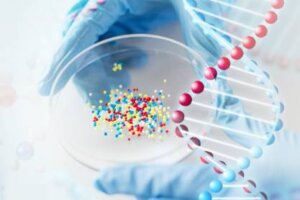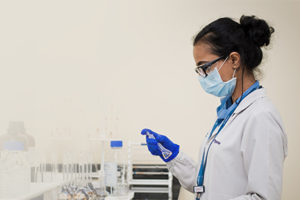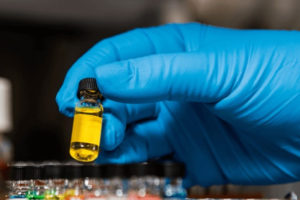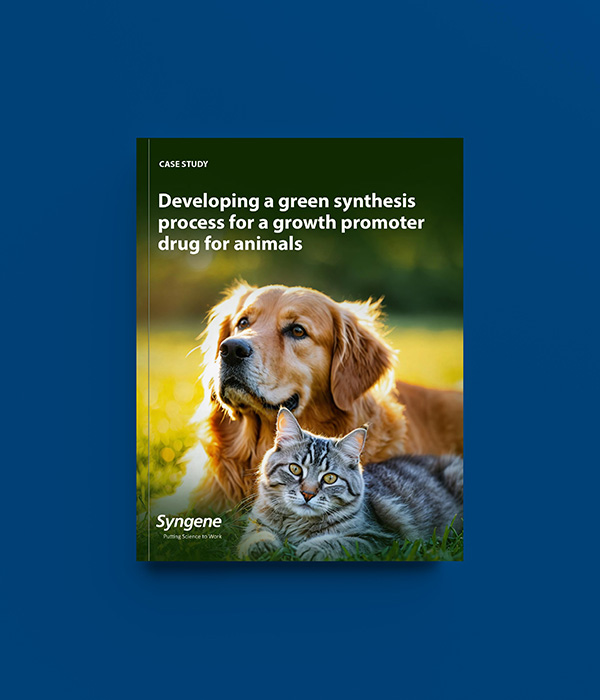The requirement
An animal health company commissioned Syngene to develop an environmentally friendly synthesis process for a growth promoter drug in phase 1 clinical trials that could drastically reduce the cumulated environmental factor (cE-factor) and process mass intensity (PMI) values compared to the traditional workflow.
Scope of work
The scope of work was as follows:
- Chromatography-free process: An alternative process to be developed to reduce excess resource usage and waste formation.
- High yield: Optimizing each synthetic step to maximize overall yield, ensuring efficiency and cost-effectiveness.
- Cost-effective reagents: Use of economical alternatives without compromising quality.
- Environmental impact reduction: Implementing green chemistry principles in tune with sustainable, eco-friendly industrial practices.
- Use of the safety, environmental, legal, economics, control, throughput (SELECT) criteria approach.
Our approach
Safety
- Solvent replacement: Replaced carcinogenic and toxic class 2 solvents with less harmful, noncarcinogenic alternatives.
- Temperature control: Conducted reactions at room temperature to reduce the risk of thermal hazards and energy consumption.
Environmental
- Solvent reduction: Replaced the column purification and extraction process with crystallization, saving 500 volumes (approximated typical batch size) of solvent.
- Waste reduction: Minimized silica gel waste in three steps. Also, eliminated the isolation of steps by telescoping it into the next steps.
- Green reagents: Replaced metal lactate with lactic acid, and pyridinium salts with less toxic and economical coupling reagents.
- Replaced the carcinogenic solvent with a less hazardous class 2 solvent in steps 1 and 4.
- Avoided column purification in two process steps by merging steps 1 and 2; implemented the crystallization process in steps 3 and 5.
- Reduced other process solvents by nearly 20% compared to the initial client process.
- Replaced expensive reagents with less expensive ones; modified the route without impacting the quality of the product in step 2; adopted usage of green solvent wherever possible.
- Improved the yield by ~15% by weight compared to the original process.
Economics
- Reagent substitution: Replaced expensive reagents and bases with more economical alternatives.
- Process efficiency: Streamlined the process to reduce costs associated with solvents and reagents, ultimately lowering overall production costs.
Control
- Process simplification: Eliminated the isolation process by combining steps, and enhancing control over the synthesis pathway.
- Reaction optimization: Optimized reaction conditions and workup parameters to improve the product quality.
Throughput
- Yield and purity improvement: Modified the synthesis route and used alternative reagents resulting in a yield improvement of nearly 10-15%.
- Improvement achieved without affecting the drug substance’s final specifications, including the purity and impurity profiles.
The outcome
- Significant improvements in environmental impact and process efficiency
- Implementing green chemistry principles and innovative synthetic strategies led to an 80% reduction in cE-factor and PMI.
Conclusion
The project resulted in the successful implementation of an efficient, chromatography-free synthesis process through the adoption of green chemistry principles and innovative synthetic strategies. Our approach minimized environmental impact by reducing waste generation and solvent usage while achieving high yields and cost-efficiency.
Our approach also demonstrates the transformative potential of sustainable practices in chemical synthesis, paving the way for greener and more eco-friendly industrial processes.
To know more about our animal health services, click here.
To contact our animal health experts, click here.







